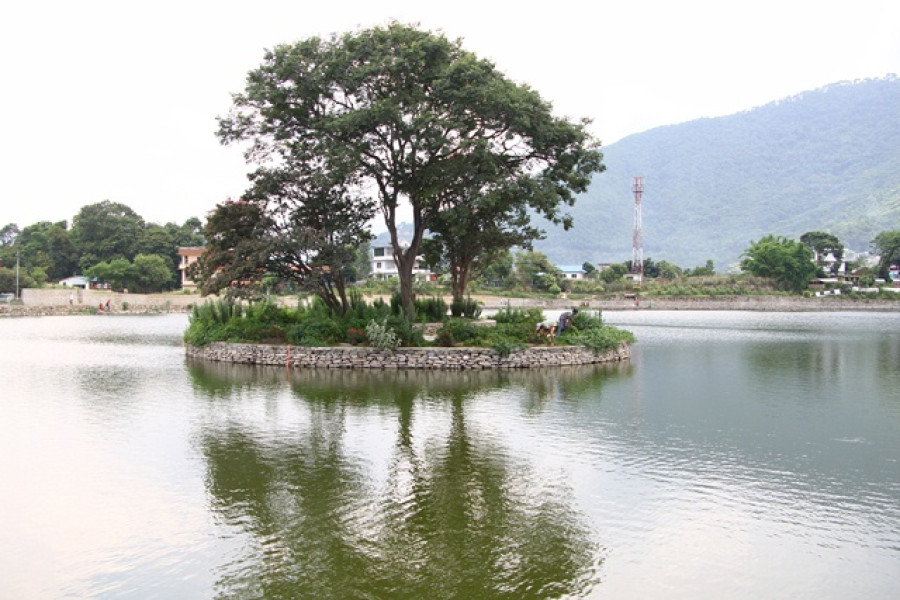Books
‘Hansa’: Dismantling myths at the Taudaha Lake
If you are looking for something light, refreshing and engaging, then pick up Sanjeev Upreti’s latest work.
Bibek Adhikari
Sanjeev Upreti’s latest foray into environmental literature, Hansa, juxtaposes realism and surrealism, portraying a myriad of issues—from diaspora experience to anthropomorphism to human sentimentality. Spread over 12 chapters, the novel exploits two narratives to tell the story of two protagonists: Prem and the whimsical duck. The first is a disillusioned poet, who invites misery into his conjugal life through alcoholism; whereas the second is a little duck at Taudaha Lake that eschews community values and wants to go beyond natural forces. The twin narratives are put together in such a way that the book is a real page-turner.
The story unfolds with a dreamlike description of the protagonist’s ‘zaar’, his wife’s second husband, and the narrator’s never-ending desire of beheading him. The hook, the very first sentence, grabs the readers’ attention and hurls them into the center of the plot. With a skilfully crafted first sentence— ‘That day my zaar’s neck shone brilliantly in the sun’ (my translation)—the narrative picks up its pace right off the bat. Then the plot thickens. One cannot help but wonder what is going to happen next. As Upreti employs a narrative technique called ‘delayed decoding’ (what Herman Melville did in Benito Cereno), the readers are left wanting to know more about what is going to happen to the zaar’s neck; however, the writer adeptly gives the plotline a hiatus, thus infusing another story—a folklore—told by an old woman of a local eatery.
The folk legend revolves around the myths of Taudaha, the first one being the story of the whimsical duck and its love affair with a black goose, one that is supposed to arrive at the lake from a mystical place, Man Sarovar. When the domesticated duck sees the beautiful goose flying, he’s instantly smitten by her. To prove his worth, he too wants to fly. He clambers up a hillock and starts exercising daily in the hopes that he will defy the laws of nature. The Uncle Duck, a rather learned and experienced duck, advises him to give up this foolish endeavour and learn to swim instead.
For Uncle Duck, swimming is the only means of exploring the past. Diving deep into the blackness of the lake, he wants to explore the myths surrounding the lake and find out the truth. All the while, a brooding heron keeps a sceptical eye on the happenings.
This legend is followed by another myth of Nag Raja and Nag Rani, and the snake queen’s illicit affair with a flying snake, Dobre. The legend goes like this: Dobre helps the snake queen recover from a fatal illness, and then the two strike a friendship. Her husband, the helpless King, succumbed to circumstances, becomes a witness of the two snakes growing a friendship. This allegorical microcosm has a bigger connection—a similar kind of story is presented in the human world through the life and times of Prem, Anuj, and Seema.
In this story, Prem is the Nag Raja, Seema is the Nag Rani, and Anuj, the Dobre snake. Moreover, the story of Anuj and Seema revolves around Kathmandu and New York, touching the lives of other (illegal) immigrants like Ram Karki, Sher Singh, and Ashraf Bhai. Imminent diasporic anxiety teems within their lives: they feel like exiles abroad, yet they cannot simply return to their native soils. The EDV lottery and the American Dream, the usual Nepali fiction tropes, are deployed in cue at this point.
Yet something is utterly fresh: the anthropomorphic stories of ducks and snakes, somewhat reminiscent of EB White’s Trumpet of the Swan in the beginning, have a different foundation—they are rooted in the Nepali soil. The yarn is peppered with numerous anecdotes, historical examples, and allegorical significance. Whatever animals do in their world seems to be connected with humankind. Nonetheless, by writing the stories of birds, snakes, and other animals and personifying their experiences, the writer has displaced an anthropocentric narrative and given due importance to marginalised stories. But this is not simply a story of birds and animals.
As Prem narrates the whole story, we are, in fact, looking at the world through his lens. What Seema did to him (or what he did to Seema) or what Anuj narrated—everything comes through the voice of the protagonist, who oftentimes withholds information, deviates from the main storyline, takes breaks and pauses, and ponders about the possibility of beheading his zaar. That is, the story contains many ‘gaps and fissures,’ the major quality of any postmodern text, and it is the duty of the readers to fill the void. These loopholes in storytelling make the narrator an unreliable one. Whatever we are reading cannot be taken for granted, not even the myths and legends—this Prem recollects in a feverish delirium from the local eatery.
Back in the story, the lovely wife’s exodus from the narrator’s life makes him question his masculinity. Since his mindset is deeply rooted in the bogland of patriarchy, he harbours misogynistic ideas—the legacy of which is passed from one generation to another. Growing up in a family that believed in subduing women’s voices by domestic violence, he becomes a byproduct of that cultural construct. His wife, Seema, albeit meek and mousy at the beginning of the story, evolves as a strong woman—taking one giant step after another. Unlike most other Nepali writers’ way of depicting female characters as mere foils or cardboard cut-outs in their novels, Upreti has done some justice to Seema by giving her some agency. Maya, another woman character, however, suffers the pangs of patriarchy: she is not as audacious as Seema.
Apart from that, the writer has also employed an invented language—onomatopoeic, alliterative, full of puns, stripped bare of consonants—for the dialogue of birds and animals. This heteroglossia makes the novel an interesting read as the diversity of voices gives the narrative a multiplicity of styles. However, the single word ‘quack’ has been used in numerous stances with a variation in its meaning. This seems a tad laborious. The repetitive use of this one pun irks the readers at times. Also, the way the writer has disguised profanity by dropping the consonants of certain words—a thought-provoking instance of defamiliarization—can be a stumbling block for some puritan readers.
The entire book is written in simple, lucid Nepali, and this language becomes too simplistic, almost devoid of any literary nuance, at times. The writer’s penchant for clean, well-honed, Hemingway-esque sentences says a lot: he wants to emphasise the subtext, the underlying meaning. But for someone like me, who cares more about the writing and the cadence of the sentences than the plot, this book turns out to be a breezy page-turner: one that can be read (and enjoyed) in a single sitting. But what about the impression it leaves behind? The novel is trifling, lingering on the verges of mental spaces.
If you are looking for something light and refreshing, something that is speckled with myths and legends, or something that speaks the everyday diasporic despair, Hansa is the right choice. One great thing about this book is the way it decentralises the anthropocentric storytelling and brings the voices of the birds and animals into consideration. But one can easily question—are these animal stories (apart from their spatiotemporal existence) even remotely related to the stories of Prem, Seema, and Anuj? Well, that is open to interpretation.
Hansa
Author: Sanjeev Upreti
Publisher: Book Hill Publications
Price: Rs 400




 7.12°C Kathmandu
7.12°C Kathmandu









%20(1).jpg&w=300&height=200)

